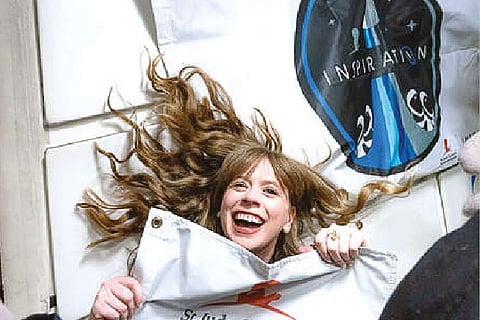

Chennai
Initially, they were chosen from the ranks of military test pilots who were white, physically fit men. Later, as NASA broadened its criteria, it still chose only astronauts who passed their physical thresholds. But that could be changing as private space flight opens space to a more diverse cross section of humanity.
For scientists, the change will create a bonanza of new data on how the human body adapts to space.
The Inspiration4 mission, which launched on Wednesday, shows how medical researchers can benefit from the new commercial space travel. The crew of four, none of whom is a professional astronaut, will spend a fair amount of time in orbit helping to advance medical research.
One of the passengers, Hayley Arceneaux, exemplifies those possibilities. At 29, she is younger than most space travellers, a cancer survivor and will be the first person in space with a prosthesis — metal rods that were implanted after a tumour was removed from her left leg.
“We’re going to learn some things that are very fundamental,” said Dorit Donoviel, executive director of the Translational Research Institute for Space Health, or TRISH, at the Baylor College of Medicine in Houston, which is coordinating research during the Inspiration4 flight. Research to date has revealed that fluids shift upward in the body in the absence of gravity — swollen heads, shrunken legs. The lack of gravity also weakens bones. Not only does radiation in space slam into DNA creating mutations, but the unusual conditions of weightlessness cause some genes to turn on and others to turn off. The biological repercussions of these alterations are not yet understood.
The crew aboard Inspiration4 will take 10 tests originally designed to gauge the mental performance of NASA astronauts each day. The tests take about 20 minutes to complete. “It needed to be brief, because astronauts kind of hate doing these things,” said Dr. Mathias Basner, a professor of psychiatry at the University of Pennsylvania who is the lead investigator for that experiment.
But in a dangerous environment like space, small errors can lead to catastrophe. “So we need our astronauts to perform at their best all the time,” Dr. Basner said. “Now, the problem is that humans are particularly bad at self-assessing their performance capability, especially in chronic exposure situations. If you sit in the same environment all the time, you think you’ll be fine, but you’re actually not.” One test is simply a square that appears on a screen, and one has to tap on it. The square changes position and progressively becomes smaller. That measures the reaction speed and eye-hand coordination. Another measures what is known as psychomotor vigilance. First, the subject stares at a box on the screen. A stopwatch suddenly pops up within the box, counting the milliseconds until the subject presses a button. “Which is extremely sensitive to sleep deprivation,” Dr. Basner said. Yet another test gauges a person’s ability to identify emotions in other people.
Chang is a tech reporter with NYT©2021
The New York Times
Visit news.dtnext.in to explore our interactive epaper!
Download the DT Next app for more exciting features!
Click here for iOS
Click here for Android